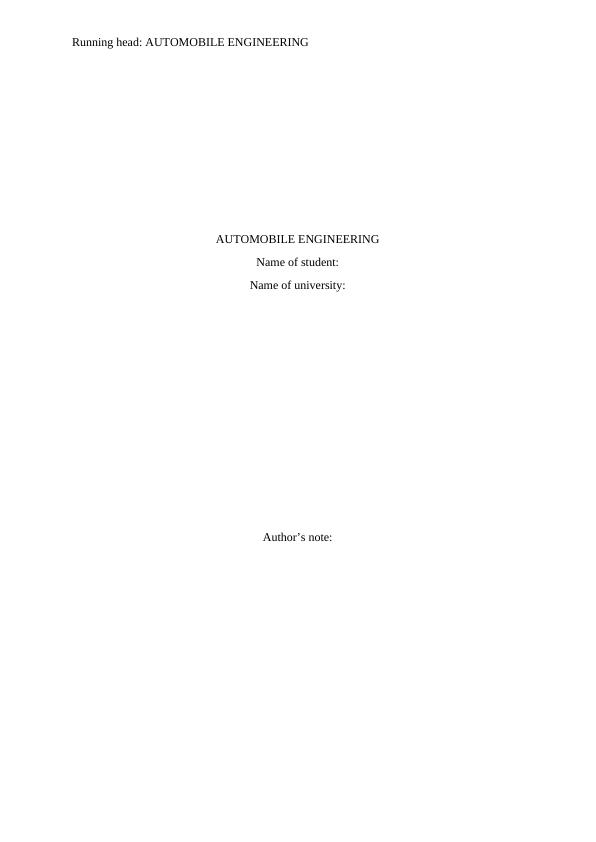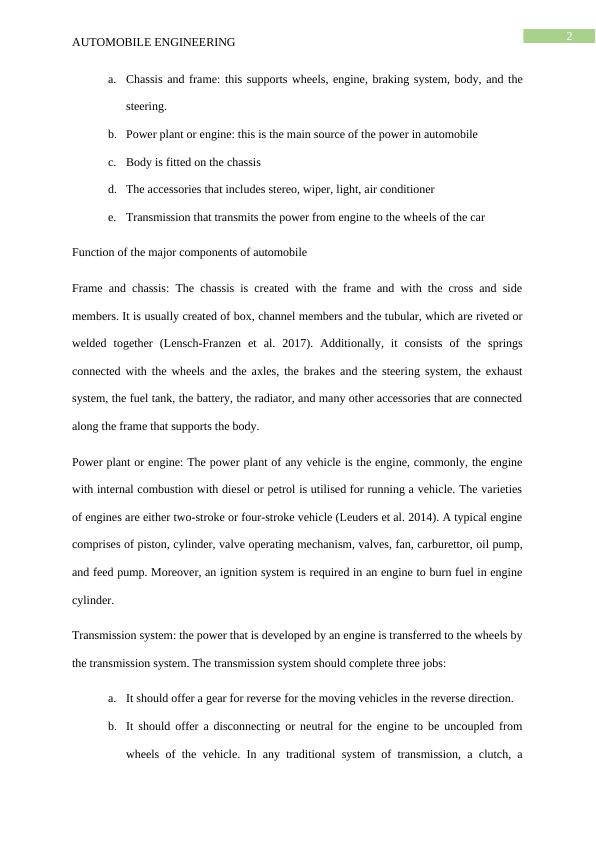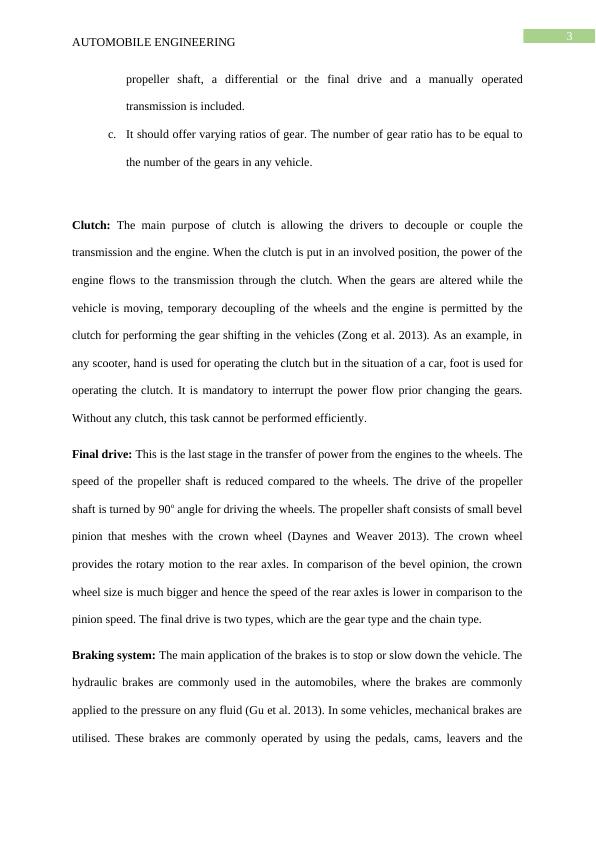Automobile Engineering: Components, Working Cycles, and Cooling Systems
Added on 2023-05-28
19 Pages3362 Words87 Views
Running head: AUTOMOBILE ENGINEERING
AUTOMOBILE ENGINEERING
Name of student:
Name of university:
Author’s note:
AUTOMOBILE ENGINEERING
Name of student:
Name of university:
Author’s note:

1
AUTOMOBILE ENGINEERING
Introduction
This report aims to perform a literature review of automobile engineering. A
comprehensive discussion of the various aspects of automobile engineering is provided in this
report. Lastly, this report concludes with an appropriate conclusion for this report.
The sector of automotive engineering combined with engineering of aerospace and
the marine engineering is the branch of vehicle engineering that incorporates the elements of
electronic, mechanical, electrical, safety engineering and software as combined to the
manufacture, design and the operation of the automobiles, trucks and the motorcycles along
with the respective subsystems of engineering (Zhang, Zhang and Wang 2013.). This also
consists of the modification of the vehicles. The domain of manufacturing deals with creation
and the assembly of the complete parts of the automobiles. The field of automotive
engineering is research comprehensive and it involves the direct application of the
mathematical formulas and the models. The major study of automotive engineering is for
designing, developing, fabricating, and test the vehicles or the components of the vehicle
from the stage of concept to the stage of production (Zifeng 2013). Production, development
and the manufacturing are the most crucial functions of this field.
Discussion
The automobile engineering branch of engineering deals with the automobiles and the
practices for propelling them. An automobile is referred to the vehicles that are driven by an
engine with internal combustion and it is commonly used as a medium of transportation of
passengers and the goods on ground. The self-driving cars are also referred as automobile.
The main components of an automobile can be categorised as:
AUTOMOBILE ENGINEERING
Introduction
This report aims to perform a literature review of automobile engineering. A
comprehensive discussion of the various aspects of automobile engineering is provided in this
report. Lastly, this report concludes with an appropriate conclusion for this report.
The sector of automotive engineering combined with engineering of aerospace and
the marine engineering is the branch of vehicle engineering that incorporates the elements of
electronic, mechanical, electrical, safety engineering and software as combined to the
manufacture, design and the operation of the automobiles, trucks and the motorcycles along
with the respective subsystems of engineering (Zhang, Zhang and Wang 2013.). This also
consists of the modification of the vehicles. The domain of manufacturing deals with creation
and the assembly of the complete parts of the automobiles. The field of automotive
engineering is research comprehensive and it involves the direct application of the
mathematical formulas and the models. The major study of automotive engineering is for
designing, developing, fabricating, and test the vehicles or the components of the vehicle
from the stage of concept to the stage of production (Zifeng 2013). Production, development
and the manufacturing are the most crucial functions of this field.
Discussion
The automobile engineering branch of engineering deals with the automobiles and the
practices for propelling them. An automobile is referred to the vehicles that are driven by an
engine with internal combustion and it is commonly used as a medium of transportation of
passengers and the goods on ground. The self-driving cars are also referred as automobile.
The main components of an automobile can be categorised as:

2
AUTOMOBILE ENGINEERING
a. Chassis and frame: this supports wheels, engine, braking system, body, and the
steering.
b. Power plant or engine: this is the main source of the power in automobile
c. Body is fitted on the chassis
d. The accessories that includes stereo, wiper, light, air conditioner
e. Transmission that transmits the power from engine to the wheels of the car
Function of the major components of automobile
Frame and chassis: The chassis is created with the frame and with the cross and side
members. It is usually created of box, channel members and the tubular, which are riveted or
welded together (Lensch-Franzen et al. 2017). Additionally, it consists of the springs
connected with the wheels and the axles, the brakes and the steering system, the exhaust
system, the fuel tank, the battery, the radiator, and many other accessories that are connected
along the frame that supports the body.
Power plant or engine: The power plant of any vehicle is the engine, commonly, the engine
with internal combustion with diesel or petrol is utilised for running a vehicle. The varieties
of engines are either two-stroke or four-stroke vehicle (Leuders et al. 2014). A typical engine
comprises of piston, cylinder, valve operating mechanism, valves, fan, carburettor, oil pump,
and feed pump. Moreover, an ignition system is required in an engine to burn fuel in engine
cylinder.
Transmission system: the power that is developed by an engine is transferred to the wheels by
the transmission system. The transmission system should complete three jobs:
a. It should offer a gear for reverse for the moving vehicles in the reverse direction.
b. It should offer a disconnecting or neutral for the engine to be uncoupled from
wheels of the vehicle. In any traditional system of transmission, a clutch, a
AUTOMOBILE ENGINEERING
a. Chassis and frame: this supports wheels, engine, braking system, body, and the
steering.
b. Power plant or engine: this is the main source of the power in automobile
c. Body is fitted on the chassis
d. The accessories that includes stereo, wiper, light, air conditioner
e. Transmission that transmits the power from engine to the wheels of the car
Function of the major components of automobile
Frame and chassis: The chassis is created with the frame and with the cross and side
members. It is usually created of box, channel members and the tubular, which are riveted or
welded together (Lensch-Franzen et al. 2017). Additionally, it consists of the springs
connected with the wheels and the axles, the brakes and the steering system, the exhaust
system, the fuel tank, the battery, the radiator, and many other accessories that are connected
along the frame that supports the body.
Power plant or engine: The power plant of any vehicle is the engine, commonly, the engine
with internal combustion with diesel or petrol is utilised for running a vehicle. The varieties
of engines are either two-stroke or four-stroke vehicle (Leuders et al. 2014). A typical engine
comprises of piston, cylinder, valve operating mechanism, valves, fan, carburettor, oil pump,
and feed pump. Moreover, an ignition system is required in an engine to burn fuel in engine
cylinder.
Transmission system: the power that is developed by an engine is transferred to the wheels by
the transmission system. The transmission system should complete three jobs:
a. It should offer a gear for reverse for the moving vehicles in the reverse direction.
b. It should offer a disconnecting or neutral for the engine to be uncoupled from
wheels of the vehicle. In any traditional system of transmission, a clutch, a

3
AUTOMOBILE ENGINEERING
propeller shaft, a differential or the final drive and a manually operated
transmission is included.
c. It should offer varying ratios of gear. The number of gear ratio has to be equal to
the number of the gears in any vehicle.
Clutch: The main purpose of clutch is allowing the drivers to decouple or couple the
transmission and the engine. When the clutch is put in an involved position, the power of the
engine flows to the transmission through the clutch. When the gears are altered while the
vehicle is moving, temporary decoupling of the wheels and the engine is permitted by the
clutch for performing the gear shifting in the vehicles (Zong et al. 2013). As an example, in
any scooter, hand is used for operating the clutch but in the situation of a car, foot is used for
operating the clutch. It is mandatory to interrupt the power flow prior changing the gears.
Without any clutch, this task cannot be performed efficiently.
Final drive: This is the last stage in the transfer of power from the engines to the wheels. The
speed of the propeller shaft is reduced compared to the wheels. The drive of the propeller
shaft is turned by 90o angle for driving the wheels. The propeller shaft consists of small bevel
pinion that meshes with the crown wheel (Daynes and Weaver 2013). The crown wheel
provides the rotary motion to the rear axles. In comparison of the bevel opinion, the crown
wheel size is much bigger and hence the speed of the rear axles is lower in comparison to the
pinion speed. The final drive is two types, which are the gear type and the chain type.
Braking system: The main application of the brakes is to stop or slow down the vehicle. The
hydraulic brakes are commonly used in the automobiles, where the brakes are commonly
applied to the pressure on any fluid (Gu et al. 2013). In some vehicles, mechanical brakes are
utilised. These brakes are commonly operated by using the pedals, cams, leavers and the
AUTOMOBILE ENGINEERING
propeller shaft, a differential or the final drive and a manually operated
transmission is included.
c. It should offer varying ratios of gear. The number of gear ratio has to be equal to
the number of the gears in any vehicle.
Clutch: The main purpose of clutch is allowing the drivers to decouple or couple the
transmission and the engine. When the clutch is put in an involved position, the power of the
engine flows to the transmission through the clutch. When the gears are altered while the
vehicle is moving, temporary decoupling of the wheels and the engine is permitted by the
clutch for performing the gear shifting in the vehicles (Zong et al. 2013). As an example, in
any scooter, hand is used for operating the clutch but in the situation of a car, foot is used for
operating the clutch. It is mandatory to interrupt the power flow prior changing the gears.
Without any clutch, this task cannot be performed efficiently.
Final drive: This is the last stage in the transfer of power from the engines to the wheels. The
speed of the propeller shaft is reduced compared to the wheels. The drive of the propeller
shaft is turned by 90o angle for driving the wheels. The propeller shaft consists of small bevel
pinion that meshes with the crown wheel (Daynes and Weaver 2013). The crown wheel
provides the rotary motion to the rear axles. In comparison of the bevel opinion, the crown
wheel size is much bigger and hence the speed of the rear axles is lower in comparison to the
pinion speed. The final drive is two types, which are the gear type and the chain type.
Braking system: The main application of the brakes is to stop or slow down the vehicle. The
hydraulic brakes are commonly used in the automobiles, where the brakes are commonly
applied to the pressure on any fluid (Gu et al. 2013). In some vehicles, mechanical brakes are
utilised. These brakes are commonly operated by using the pedals, cams, leavers and the

End of preview
Want to access all the pages? Upload your documents or become a member.
Related Documents
Energy Efficiency Opportunities in Automotive Assembly Processlg...
|13
|3269
|25
Activity Based Budgeting (ABB)lg...
|13
|3874
|361
Toyota Competitive Strategy: Porter's Five Forces, SWOT and PESTLE Analysislg...
|8
|1765
|325
